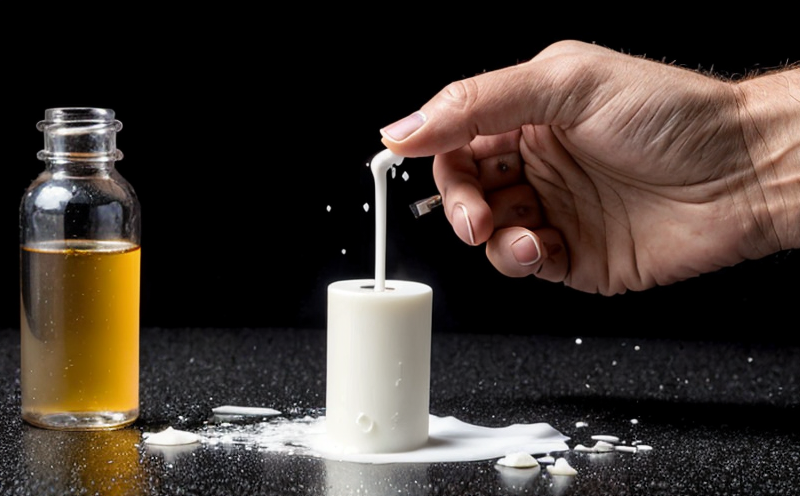USP Disintegration Testing of Sublingual Tablets
The United States Pharmacopeia (USP) disintegration test is a critical quality control method used to assess the integrity and dissolution characteristics of pharmaceutical dosage forms, including sublingual tablets. This test ensures that medications administered under the tongue fully break down within the specified time frame, releasing their active ingredients effectively into the bloodstream. For sublingual tablets, this process is crucial as it impacts both efficacy and patient comfort.
The USP disintegration test is particularly important for sublingual dosage forms because these tablets are designed to dissolve rapidly in the oral cavity. The primary goal of the test is to verify that the tablet breaks down into its constituent particles within a defined time limit, typically not exceeding 30 minutes or as specified by the USP monograph.
The disintegration test involves placing the sublingual tablet in a solution (usually water) at controlled temperature and observing the dissolution process over time. The apparatus used for this test includes a USP Dissolution Apparatus I or II, depending on the type of dosage form being tested. These devices ensure precise control over temperature, stirring speed, and timing.
The results of the disintegration test are critical as they directly impact patient compliance and medication efficacy. If a sublingual tablet does not disintegrate properly, it may result in incomplete absorption of the active ingredient, leading to potential therapeutic failures or side effects. In contrast, rapid disintegration ensures that the drug is released quickly, enhancing its bioavailability.
It’s important to note that the USP provides specific guidelines for conducting this test, which are meticulously followed by laboratories specializing in pharmaceutical testing. These guidelines include precise temperature control, sample preparation methods, and detailed observation criteria. Adhering strictly to these protocols ensures accurate and reliable results.
The importance of the disintegration test extends beyond just ensuring rapid dissolution; it also plays a vital role in patient safety. For instance, if a sublingual tablet contains allergens or other potentially harmful substances that do not fully break down, there could be risks associated with their release into the oral cavity. The USP disintegration test helps mitigate these risks by providing a standardized method to evaluate the stability and integrity of the dosage form.
In summary, the USP disintegration testing of sublingual tablets is an essential quality control measure that guarantees the safe and effective administration of sublingual medications. By ensuring rapid and complete dissolution, this test enhances patient outcomes while maintaining regulatory compliance standards.
Applied Standards
| Standard | Description |
|---|---|
| USP United States Pharmacopeia | The USP disintegration test is outlined in the official monograph for sublingual tablets. This standard provides specific criteria for temperature, time limits, and observation techniques. |
| ASTM American Society for Testing and Materials | ASTM standards are often referenced in conjunction with USP guidelines to provide additional technical details on dissolution testing apparatus and procedures. |
The USP disintegration test is based on the principles outlined in the official monograph for sublingual tablets, which specify the temperature, time limits, and observation techniques. Compliance with these standards ensures that the results of the test are accurate and reliable. Additionally, ASTM standards provide supplementary information on apparatus design and operational procedures.
Scope and Methodology
The USP disintegration testing of sublingual tablets involves a series of precise steps to ensure accurate results. The first step is the preparation of the test solution, which typically consists of water at a specific temperature (usually 37°C ± 1°C). Next, one or more tablets are placed in the dissolution apparatus according to the USP monograph.
The dissolution apparatus can be either a USP Dissolution Apparatus I or II. For sublingual tablets, the latter is often used due to its ability to simulate physiological conditions more closely. The test is conducted under continuous stirring and at controlled temperature. The process continues until all the tablets have disintegrated into their constituent particles.
The test results are recorded based on the time required for complete disintegration. Typically, this period does not exceed 30 minutes. However, the exact duration may vary depending on the specific USP monograph for the tablet being tested. After completion of the test, the residues are examined to ensure they meet the specified criteria for particle size and composition.
The precision and accuracy of the USP disintegration test depend heavily on adherence to these procedures. Variations in temperature or stirring speed can significantly affect the outcome. Therefore, strict adherence to the USP guidelines is essential to maintain consistency and reliability in the results.
Use Cases and Application Examples
- New Product Development: During the early stages of product development, the disintegration test helps researchers optimize formulation parameters to ensure rapid dissolution.
- Quality Control: In production environments, this test ensures that each batch of sublingual tablets meets the required standards for disintegration time and particle size.
- Drug Delivery Optimization: By understanding how quickly a tablet dissolves, manufacturers can adjust formulation to improve bioavailability.
- Regulatory Compliance: Pharmaceutical companies must comply with USP guidelines during clinical trials and post-market surveillance.
- Patient Safety: Ensuring proper disintegration prevents potential side effects from incomplete medication release.
The USP disintegration test is a cornerstone of quality assurance in the pharmaceutical industry. Its application extends across various stages, from research and development to manufacturing and post-market surveillance. By adhering to these standards, manufacturers can ensure that their sublingual tablets are safe, effective, and meet regulatory requirements.





